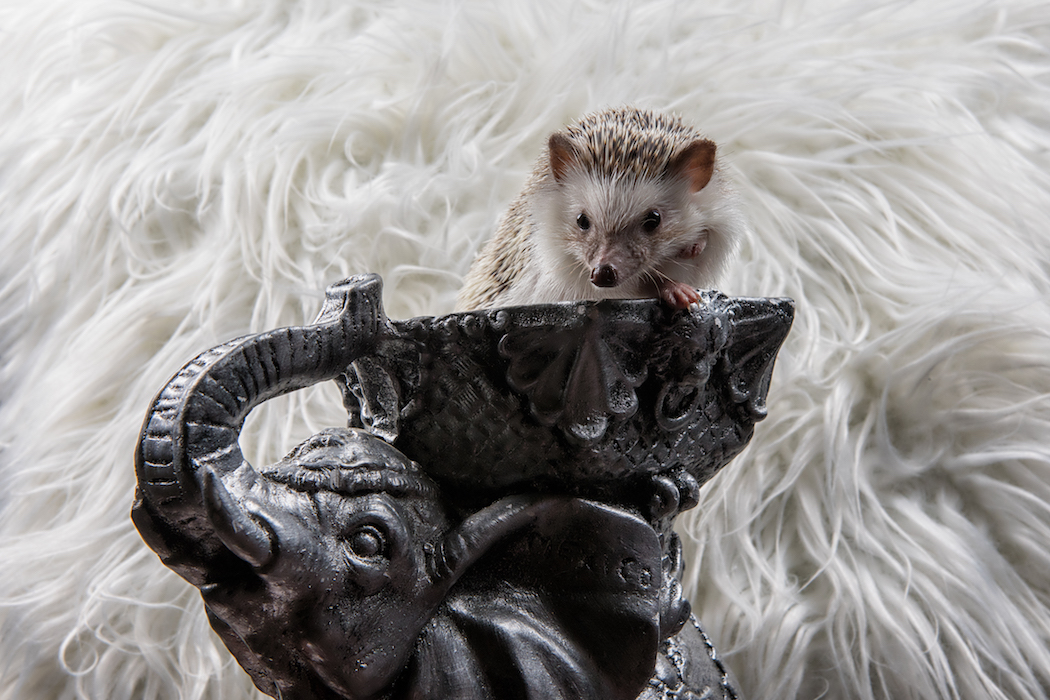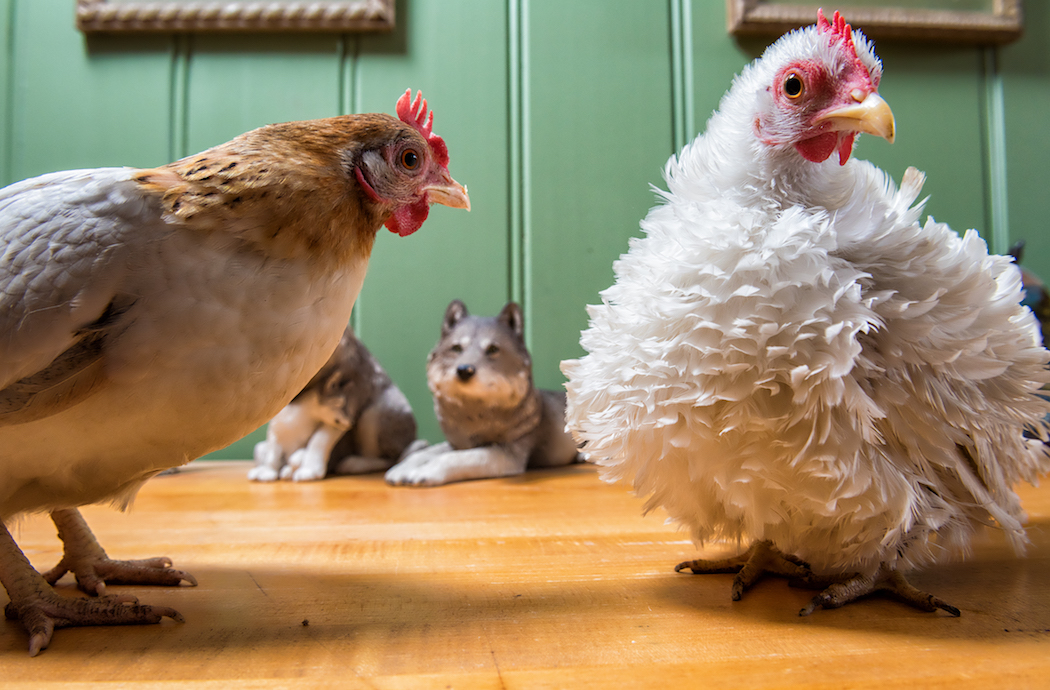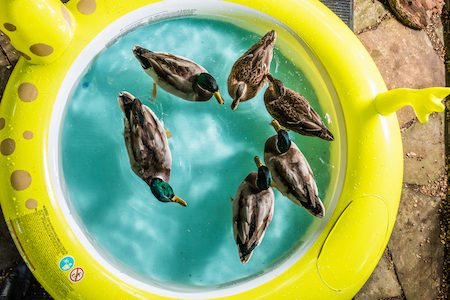Meet some of the most unusual animal friends living in East Dallas
Animals have an amazing way of enriching our lives, whether they be the traditional cat or dog, or something less conventionally cute, like a tarantula. Highlighted here are the critters who many might think twice before letting in their house, but these neighbors say they are just as full of love as any four- (or two, or eight) legged friend. Also included is the winner of the Advocate Pet Contest, selected by readers from dozens of entries submitted this year.
The menagerie

Cali the hedgehog strikes a pose (Photo by Danny Fulgencio)
What lives in Old Lake Highlands and has 12 legs, long ears, a spiky back and a sack of skin that puffs up like a beard?
It isn’t a mysterious lake monster, but three of Sonay and Colt Baker’s pets. Their rabbit, bearded dragon and hedgehog make for quite the diverse household.
Sonay is a pet photographer and former zookeeper, but Colt is the one who researches how to care for this unique herd.
Their rabbit, Henry, has free range of the house much like an indoor cat, though he is more likely to gnaw through the coffee table than your average feline. Thankfully, this bunny is litterbox trained and gets along swimmingly with his three canine companions. Henry has starred in many an Easter portrait alongside neighborhood children, and isn’t scared to hop in your lap and snuggle up. That isn’t to say he can’t spook an unsuspecting victim, as his blood red eyes on his white fur are reminiscent of Bunnicula the vampire rabbit.
Cali, the hedgehog, hates to be out of his cage, his safe space. He makes a snorting sound that would be terrifying if he wasn’t 8-inches long. He retreats into a spiky ball when he feels threatened, and in nature, hedgehogs actually do roll down termite mounds in a ball like Sonic from the video game. Cali loves to go for night runs, when her exercise wheel can be heard squeaking through the house.
The bearded dragon gets its name from a sack of skin that is a darker color below the reptile’s mouth, looking like a beard as he puffs it up when he senses danger. The Bakers say that these lizards are great for children because they don’t have teeth, and their own little dragon, Maui, is relaxed enough to ride around on your shoulder.
It will come as no surprise to anyone that Colt grew up training horses while Sonay’s mother was certified to rehab raccoons and possums at her childhood home. Zoos are a staple of the Bakers’ vacations these days, where Sonay uses her connections to get behind the scenes for up-close animal encounters.
“It’s how I knew we were a good fit,” Sonny said of Colt. “We have a lot of love to give.”
Wallace to the rescue
 Sonay Baker’s love for animals goes deeper than most. Her dog Wallace once saved her from a home intruder. A man walked into her open garage and up to her kitchen door when Wallace started barking. Baker turned as the man asked, “Is this the open house?” There was no open house. Wallace, sensing the danger, attempted to bite the man, and as the intruder jumped back and kicked the fur ball, Baker was able to shut and lock the door. Wallace was fine, but later that week, Baker received notice that a woman had been attacked at her complex that week by a man of the same description.
Sonay Baker’s love for animals goes deeper than most. Her dog Wallace once saved her from a home intruder. A man walked into her open garage and up to her kitchen door when Wallace started barking. Baker turned as the man asked, “Is this the open house?” There was no open house. Wallace, sensing the danger, attempted to bite the man, and as the intruder jumped back and kicked the fur ball, Baker was able to shut and lock the door. Wallace was fine, but later that week, Baker received notice that a woman had been attacked at her complex that week by a man of the same description.
House of cluck

Lucky and Blanca are Bantam chickens that enjoy indoor privileges. (Photo by Danny Fulgencio)
Lucky the chicken was a feather’s width from becoming garbage. When the rest of her siblings hatched, her egg remained unbroken, so Laura Birdwell-Meyeres threw her in the trashcan with the rest of the unhatched shells.
Later that day, she heard a chirping in the garage while doing laundry and assumed it was the other baby chicks down the hall. When she left the garage and could no longer hear the small sound, she rushed to the can and rifled through garbage to unearth a lightly chirping egg.
Birdwell-Meyeres eventually peeled back the shell to find a small chick, somewhat bewildered. “If you stay alive I promise not to give you away,” she told the chick.
Lucky is a Serama, a smooth-feathered chicken in the Bantam category, who lives alongside three other Bantams in the back yard including another Serama named Olive. Millie is the Mille Fleur d-Uccle chicken, which looks like it has misplaced feathers on its feet. Blanca is the Serama Frizzle, distinctive by her permanent bed-head style.
Raising Lucky and the other Bantams has become a family affair, as the chickens now join the family on the couch for movies. “The kids have learned great responsibility and many lessons about life and death,” says Birdwell-Meyeres. “All the work is worth it for the kids.”
The Bantams have assumed normal pet roles around the Casa Linda house. They sleep inside the house, and as afternoons turn into evenings, they tap the window as they wait to be invited inside.
In addition to these four smaller chickens, Birdwell-Meyeres has 14 laying hens, and they are also constructing a Texas Rustic-style chicken coop to join the designer chicken coop circuit (yes, that’s a real thing).
Ironically, Birdwell-Meyeres won a pass to the grand opening of the Garland Road Chick-Fil-A, but no longer eats chicken. “When I have held them and nursed them back to health, I just can’t do it,” she says. “We have turned into chicken people. I am the crazy chicken lady, but not too crazy.”
Eight-legged freaks

Bluefoot the tarantula’s mesmerizing color is just part of what keeps his owner, Teak Esneault, mesmerized. (Photo by Danny Fulgencio)
When you are born on Halloween, you may be destined to have a weird pet. This was the case for Teak Rocket Esneault when he turned 8 and his father bought him Bluefoot, a Venezuelan Green Bottle Blue Tarantula.
Bluefoot’s appearance will live up to her name on her final molt, which hasn’t happened yet. And if the idea of a large, colorful and hairy arachnid in the house creeps you out, its food might be even more disturbing. Teak keeps a container of live cockroaches in his closet to feed the eight-legged friend, as Bluefoot won’t eat anything dead.
Unlike spiders, tarantulas don’t use their web to capture prey; they prefer to hunt and pounce. Though they are scared of people, tarantulas have fangs and venom. To a human, their venom is weaker than a bee sting, but it can paralyze their prey. They then release digestive enzymes to melt the innards of their prey, allowing the tarantula to suck out the nutrients.
A tarantula can survive months without food but can also eat several cockroaches in a couple days. Teak enjoys watching his pet hunt prey and spin webs into a protective shield before it molts its skin and grows.
If all of this hasn’t induced enough nightmares, tarantulas can also urticate the bristles on their legs, allowing them to shoot the hairs into a perceived threat, which can cause a rash in humans.
Bluefoot may be with Teak until his mid-20s, as females can live to be 15. They are extremely hard to breed, so she will probably stay a single tarantula for the time being. “They usually don’t eat their mates,” he says. “But they should both be well fed before mating.”

With her squishy pug face, it’s easy to see why Advocate readers voted for Tessa. The 8-year-old pug lives in Lakewood Trails with her humans Julia and Clint Bell. Julia raised Tessa from puppyhood, and Clint adopted her when they got married. “My wife swears she is part human,” Clint says. “Tess has so much personality from the way she walks, looking out the window for my wife to get home, snoring with her eyes open, her farts, barking at bigger dogs as they walk away, rolling in anything that smells bad and spending all day on one or both of her couches.”

Down with ducks

Beth Vercillo has transformed her back porch into a duck sanctuary. Photo by Danny Fulgencio.
When injured or out of place animals are spotted in Lakewood, Beth Vercillo often gets the call. She has rehabilitated squirrels, possums and even a lost swan.
“I say yes every time,” she says.
Her latest flock includes six ducklings that live on her back porch, which has been turned into a fowl habitation. The caretaking of this quacking crew is self-imposed, as she ordered these eggs herself.
With a house that backs up to a dammed creek, she has the perfect environment to raise these webbed wonders.
Vercillo says she missed wings, feathers and flippers after she lost her pet swans due to a combination of coyotes and storms, so she ordered eggs.
Vercillo would chirp at the unhatched eggs the same way a mother might read to her baby in the womb. She says they responded and even giggled within the eggs. Soon Bandit, Dasher, Meriweather, Una, Willow and Chicken hatched in their home.
The babies imprint on the first animal they see when they hatch, which was Vercillo. Now 11 weeks old, the gaggle of six ducks jump in and out of her lap as she sits on the back porch feeding them mealworms. They follow her around and would definitely follow her into the house, if she let them.
They first stayed in a toddler’s playpen, placed in an extra bedroom equipped with a heat lamp and water element. The ducklings also spent time in the bathtub, where they could practice going under the water.
“It’s a lot of work, a real commitment,” she says.
Vercillo wears mucking boots to clean out the duck house, refills their pool and replaces their wood chips. Despite all the hours she puts into their care, Vercillo knows that when the ducks are ready, they may leave her forever. But like any good parent, she knows that she needs to let them go.
“This is big fun for us, and the ducks are always smiling,” she says. “This is what we do.”





